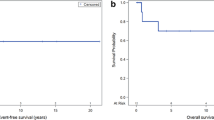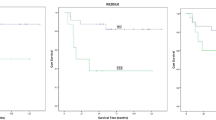Abstract
Pediatric embryonal brain tumor patients treated with craniospinal irradiation (CSI) are at risk for adverse effects, with greater severity in younger patients. Here we compare outcomes of CSI vs. high-dose chemotherapy (HD), stem cell transplant (SCT) and delayed CSI in newly diagnosed patients. Two hundred one consecutive patients treated for medulloblastoma (72 %), supratentorial primitive neuroectodermal tumor (sPNET; 18 %) or pineoblastoma (10 %) at two institutions between 1988 and 2014 were retrospectively identified. Progression free survival (PFS) and overall survival (OS) were estimated using the Kaplan–Meier method and compared by log-rank tests. Adjuvant CSI regimens were used for 56 % of patients (upfront-CSI), and HD/SCT regimens were used in 32 % of patients. HD/SCT patients were significantly younger than those receiving upfront-CSI (2.9 vs. 7.8 years; P < 0.0001). There were no differences in metastases, extent of resection, or CSI dose between upfront-CSI and HD/SCT patients, but median follow-up was shorter in the HD/SCT group (6.2 vs. 3.9 years; P = 0.007). There were no significant outcome differences between upfront-CSI and HD/SCT patients who received CSI as a prophylaxis or following relapse (OS 66 % vs. 61 %, P = 0.13; PFS 67 % vs. 62 %, P = 0.12). Outcomes were equivalent when restricting analyses to HD/SCT patients who received prophylactic CSI prior to relapse (OS 66 % vs. 65 %, P = 0.5; PFS 67 % vs. 74 %, P = 0.8). At last follow-up, 48 % of HD/SCT patients had received neither definitive nor salvage radiotherapy. In this retrospective cohort, outcomes with adjuvant HD/SCT followed by delayed CSI are comparable to upfront-CSI for carefully surveyed pediatric embryonal brain tumor patients. Future prospective studies are required to validate this finding, and also to assess the impact of delayed CSI on neurocognitive outcomes.


Similar content being viewed by others
Abbreviations
- CI:
-
Confidence interval
- CSI:
-
Craniospinal irradiation
- GTR:
-
Gross total resection
- HD:
-
High dose chemotherapy
- HR:
-
Hazard ratio
- MRI:
-
Magnetic resonance imaging
- OS:
-
Overall survival
- PFS:
-
Progression free survival
- RT:
-
Radiotherapy
- SCT:
-
Stem cell transplant
- sPNET:
-
Supratentorial primitive neuroectodermal tumor
- STR:
-
Subtotal resection
References
Ostrom QT, Gittleman H, Liao P et al (2014) CBTRUS statistical report: primary brain and central nervous system tumors diagnosed in the United States in 2007–2011. Neurooncol 16(Suppl 4):iv1–i63. doi:10.1093/neuonc/nou223
Siegel RL, Miller KD, Jemal A (2015) Cancer statistics, 2015. CA Cancer J Clin 65:5–29. doi:10.3322/caac.21254
Gajjar A, Chintagumpala M, Ashley D et al (2006) Risk-adapted craniospinal radiotherapy followed by high-dose chemotherapy and stem-cell rescue in children with newly diagnosed medulloblastoma (St Jude Medulloblastoma-96): long-term results from a prospective, multicentre trial. Lancet Oncol 7:813–820. doi:10.1016/S1470-2045(06)70867-1
Kieran MW, Walker D, Frappaz D, Prados M (2010) Brain tumors: from childhood through adolescence into adulthood. J Clin Oncol 28:4783–4789. doi:10.1200/JCO.2010.28.3481
Palmer SL, Armstrong C, Onar-Thomas A et al (2013) Processing speed, attention, and working memory after treatment for medulloblastoma: an international, prospective, and longitudinal study. J Clin Oncol 31:3494–3500. doi:10.1200/JCO.2012.47.4775
Perkins SM, Fei W, Mitra N, Shinohara ET (2013) Late causes of death in children treated for CNS malignancies. J Neurooncol 115:79–85. doi:10.1007/s11060-013-1197-0
Merchant TE, Conklin HM, Wu S et al (2009) Late effects of conformal radiation therapy for pediatric patients with low-grade glioma: prospective evaluation of cognitive, endocrine, and hearing deficits. J Clin Oncol 27:3691–3697. doi:10.1200/JCO.2008.21.2738
Taylor MD, Northcott PA, Korshunov A et al (2012) Molecular subgroups of medulloblastoma: the current consensus. Acta Neuropathol 123:465–472. doi:10.1007/s00401-011-0922-z
Hoff von K, Hinkes B, Gerber NU et al (2009) Long-term outcome and clinical prognostic factors in children with medulloblastoma treated in the prospective randomised multicentre trial HIT‘91. Eur J Cancer 45:1209–1217. doi:10.1016/j.ejca.2009.01.015
Tarbell NJ, Friedman H, Polkinghorn WR et al (2013) High-risk medulloblastoma: a pediatric oncology group randomized trial of chemotherapy before or after radiation therapy (POG 9031). J Clin Oncol 31:2936–2941. doi:10.1200/JCO.2012.43.9984
Bailey CC, Gnekow A, Wellek S et al (1995) Prospective randomised trial of chemotherapy given before radiotherapy in childhood medulloblastoma. International Society of Paediatric Oncology (SIOP) and the (German) Society of Paediatric Oncology (GPO): SIOP II. Med Pediatr Oncol 25:166–178
Taylor RE (2003) Results of a randomized study of preradiation chemotherapy versus radiotherapy alone for nonmetastatic medulloblastoma: the International Society of Paediatric Oncology/United Kingdom Children’s Cancer Study Group PNET-3 Study. J Clin Oncol 21:1581–1591. doi:10.1200/JCO.2003.05.116
Taylor RE, Bailey CC, Robinson KJ et al (2005) Outcome for patients with metastatic (M2–3) medulloblastoma treated with SIOP/UKCCSG PNET-3 chemotherapy. Eur J Cancer 41:727–734. doi:10.1016/j.ejca.2004.12.017
Duffner PK, Horowitz ME, Krischer JP et al (1993) Postoperative chemotherapy and delayed radiation in children less than three years of age with malignant brain tumors. N Engl J Med 328:1725–1731. doi:10.1056/NEJM199306173282401
Lannering B, Rutkowski S, Doz F et al (2012) Hyperfractionated versus conventional radiotherapy followed by chemotherapy in standard-risk medulloblastoma: results from the randomized multicenter HIT-SIOP PNET 4 trial. J Clin Oncol 30:3187–3193. doi:10.1200/JCO.2011.39.8719
Rutkowski S, Bode U, Deinlein F et al (2005) Treatment of early childhood medulloblastoma by postoperative chemotherapy alone. N Engl J Med 352:978–986. doi:10.1056/NEJMoa042176
Ashley DM, Merchant TE, Strother D et al (2012) Induction chemotherapy and conformal radiation therapy for very young children with nonmetastatic medulloblastoma: children’s oncology group study P9934. J Clin Oncol 30:3181–3186. doi:10.1200/JCO.2010.34.4341
Gerber NU, Hoff von K, Resch A et al (2014) Treatment of children with central nervous system primitive neuroectodermal tumors/pinealoblastomas in the prospective multicentric trial HIT 2000 using hyperfractionated radiation therapy followed by maintenance chemotherapy. Int J Rad Oncol Biol Phys 89:863–871. doi:10.1016/j.ijrobp.2014.04.017
Dhall G, Grodman H, Ji L et al (2008) Outcome of children less than three years old at diagnosis with non-metastatic medulloblastoma treated with chemotherapy on the “Head Start” I and II protocols. Pediatr Blood Cancer 50:1169–1175. doi:10.1002/pbc.21525
Jakacki RI, Burger PC, Zhou T et al (2012) Outcome of children with metastatic medulloblastoma treated with carboplatin during craniospinal radiotherapy: a Children’s Oncology Group Phase I/II study. J Clin Oncol 30:2648–2653. doi:10.1200/JCO.2011.40.2792
Dufour C, Kieffer V, Varlet P et al (2014) Tandem high-dose chemotherapy and autologous stem cell rescue in children with newly diagnosed high-risk medulloblastoma or supratentorial primitive neuro-ectodermic tumors. Pediatr Blood Cancer 61:1398–1402. doi:10.1002/pbc.25009
Chang CH, Housepian EM, Herbert C (1969) An operative staging system and a megavoltage radiotherapeutic technic for cerebellar medulloblastomas. Radiology 93:1351–1359. doi:10.1148/93.6.1351
Rutkowski S, Gerber NU, Hoff von K et al (2009) Treatment of early childhood medulloblastoma by postoperative chemotherapy and deferred radiotherapy. Neuro-oncol 11:201–210. doi:10.1215/15228517-2008-084
Rudin CM, Hann CL, Laterra J et al (2009) Treatment of medulloblastoma with hedgehog pathway inhibitor GDC-0449. N Engl J Med 361:1173–1178. doi:10.1056/NEJMoa0902903
Yauch RL, Dijkgraaf GJP, Alicke B et al (2009) Smoothened mutation confers resistance to a Hedgehog pathway inhibitor in medulloblastoma. Science 326:572–574. doi:10.1126/science.1179386
Northcott PA, Jones DTW, Kool M et al (2012) Medulloblastomics: the end of the beginning. Nat Rev Cancer 12:818–834. doi:10.1038/nrc3410
Moxon-Emre I, Taylor MD, Bouffet E et al (2016) Intellectual outcome in molecular subgroups of medulloblastoma. J Clin Oncol. doi:10.1200/JCO.2016.66.9077
Thompson EM, Hielscher T, Bouffet E et al (2016) Prognostic value of medulloblastoma extent of resection after accounting for molecular subgroup: a retrospective integrated clinical and molecular analysis. Lancet Oncol. doi:10.1016/S1470-2045(15)00581-1
Author information
Authors and Affiliations
Corresponding author
Ethics declarations
Conflict of interest
The authors declare that they have no conflict of interest.
Electronic supplementary material
Below is the link to the electronic supplementary material.
11060_2016_2307_MOESM1_ESM.pdf
Supplemental Figure 1. Medulloblastoma outcomes in patients younger than 3 years of age at diagnosis according to adjuvant treatment regimen. (A) OS and (B) PFS in patients with medulloblastoma who were younger than 3 years of age at diagnosis, analyzed according to adjuvant regimen. (PDF 329 KB)
Rights and permissions
About this article
Cite this article
Raleigh, D.R., Tomlin, B., Buono, B.D. et al. Survival after chemotherapy and stem cell transplant followed by delayed craniospinal irradiation is comparable to upfront craniospinal irradiation in pediatric embryonal brain tumor patients. J Neurooncol 131, 359–368 (2017). https://doi.org/10.1007/s11060-016-2307-6
Received:
Accepted:
Published:
Issue Date:
DOI: https://doi.org/10.1007/s11060-016-2307-6




